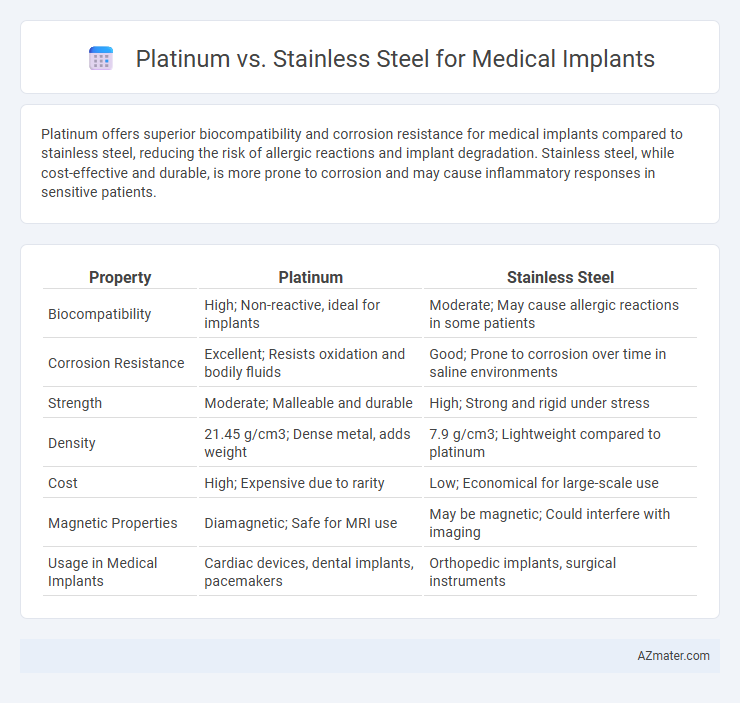Platinum offers superior biocompatibility and corrosion resistance for medical implants compared to stainless steel, reducing the risk of allergic reactions and implant degradation. Stainless steel, while cost-effective and durable, is more prone to corrosion and may cause inflammatory responses in sensitive patients.
Table of Comparison
| Property | Platinum | Stainless Steel |
|---|---|---|
| Biocompatibility | High; Non-reactive, ideal for implants | Moderate; May cause allergic reactions in some patients |
| Corrosion Resistance | Excellent; Resists oxidation and bodily fluids | Good; Prone to corrosion over time in saline environments |
| Strength | Moderate; Malleable and durable | High; Strong and rigid under stress |
| Density | 21.45 g/cm3; Dense metal, adds weight | 7.9 g/cm3; Lightweight compared to platinum |
| Cost | High; Expensive due to rarity | Low; Economical for large-scale use |
| Magnetic Properties | Diamagnetic; Safe for MRI use | May be magnetic; Could interfere with imaging |
| Usage in Medical Implants | Cardiac devices, dental implants, pacemakers | Orthopedic implants, surgical instruments |
Introduction to Medical Implant Materials
Platinum and stainless steel are widely used materials for medical implants due to their biocompatibility and corrosion resistance. Platinum offers superior inertness and excellent conductivity, making it ideal for cardiac pacemakers and neural interfaces, while stainless steel provides strength, ease of manufacturing, and cost-effectiveness for orthopedic implants. Selecting the appropriate material depends on the implant's mechanical requirements, biological environment, and long-term performance needs.
Overview of Platinum and Stainless Steel
Platinum is a precious metal known for its excellent biocompatibility, corrosion resistance, and non-reactive properties, making it highly suitable for long-term medical implants such as cardiac devices and orthopedic hardware. Stainless steel, primarily composed of iron, chromium, and nickel, offers high strength, durability, and cost-effectiveness but may have a higher risk of corrosion and metal ion release in the body over time. Both materials are widely used in medical implants, with platinum favored for critical applications requiring superior biocompatibility and stainless steel chosen for structural components where mechanical strength and budget constraints are prioritized.
Biocompatibility Comparison
Platinum exhibits superior biocompatibility compared to stainless steel, making it highly resistant to corrosion and minimizing adverse tissue reactions in medical implants. Stainless steel, while cost-effective and strong, can release metal ions that may cause inflammation or allergic responses over time. The inert nature of platinum reduces the likelihood of immune rejection, ensuring better long-term integration with body tissues in implant applications.
Corrosion Resistance in Medical Environments
Platinum exhibits superior corrosion resistance compared to stainless steel in medical implant environments due to its inertness and resistance to body fluids, minimizing the risk of metal ion release and implant degradation. Stainless steel, although commonly used, may corrode over time in the presence of bodily fluids, especially in chloride-rich environments, potentially leading to inflammation or implant failure. The high corrosion resistance of platinum alloys ensures enhanced biocompatibility and long-term stability in corrosive medical environments.
Mechanical Strength and Durability
Platinum exhibits excellent corrosion resistance and biocompatibility but has lower mechanical strength compared to stainless steel, limiting its use in load-bearing medical implants. Stainless steel, particularly 316L grade, offers superior mechanical strength and durability, making it ideal for implants subject to high stress and wear. The combination of strength, fatigue resistance, and cost-effectiveness ensures stainless steel remains the preferred choice for many structural medical implants.
Imaging Compatibility: MRI and X-Ray Considerations
Platinum offers superior imaging compatibility for medical implants due to its non-ferromagnetic properties, resulting in minimal MRI artifacts and clearer X-ray images compared to stainless steel. Stainless steel, often containing ferromagnetic elements like iron, can distort magnetic resonance imaging and create significant artifacts, complicating diagnosis and treatment planning. Choosing platinum enhances patient safety and imaging accuracy, especially crucial for ongoing monitoring of implant integration and surrounding tissue health.
Cost Analysis of Platinum vs Stainless Steel Implants
Platinum implants typically incur higher upfront costs due to the metal's rarity and superior biocompatibility, making them ideal for long-term applications with lower risk of adverse reactions. Stainless steel implants offer a more cost-effective solution, favored in short-term or budget-sensitive procedures, despite a higher potential for corrosion and metal ion release. Evaluating total cost-effectiveness requires factoring in potential complications, implant longevity, and patient-specific outcomes, with platinum often justifying expenses through enhanced durability and reduced revision surgeries.
Allergic Reactions and Hypersensitivity Risks
Platinum for medical implants exhibits superior biocompatibility with minimal allergic reactions and hypersensitivity risks compared to stainless steel, which often contains nickel known to cause contact dermatitis and metal hypersensitivity in sensitive patients. Stainless steel implants can provoke immune responses leading to inflammation or implant rejection, whereas platinum's inert properties reduce these complications. Selecting platinum minimizes allergic complications and enhances patient outcomes in implant surgeries.
Common Applications and Use Cases
Platinum is favored for medical implants requiring exceptional biocompatibility and corrosion resistance, including cardiac pacemaker electrodes and neurostimulators. Stainless steel is commonly used in orthopedic implants like bone plates, screws, and temporary fixation devices due to its high strength and cost-effectiveness. Both materials play a crucial role in implantable medical devices, with platinum often reserved for long-term, sensitive applications and stainless steel for structural and temporary support.
Future Trends in Implant Material Selection
Platinum and stainless steel both serve as critical materials in medical implants, with platinum offering superior biocompatibility and corrosion resistance while stainless steel provides cost-effectiveness and mechanical strength. Future trends in implant material selection emphasize the integration of advanced alloys and surface modifications to enhance osseointegration and reduce immune response, prioritizing patient-specific customization through additive manufacturing technologies. Emerging research highlights the potential of platinum-based nanocomposites combined with bioactive coatings to revolutionize long-term implant performance and durability.

Infographic: Platinum vs Stainless steel for Medical Implant
 azmater.com
azmater.com